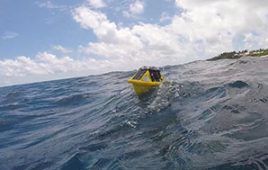Taking a Close Look at Unique Diamonds
 |
| The Wittelsbach-Graff diamond (31.06 ct, left) and the Hope diamond (45.52 ct, right) apparently were not cut from the same crystal, even though they share several similarities, such as strong red phosphorescence (bottom). Courtesy of Chip Clark, Smithsonian |
The song says that “diamonds are a girl’s best friend,” but scientists are finding that diamonds are a researcher’s best friend too. Many of the properties of diamond necessary for technology are impacted by defects and impurities present in the lattice. In collaboration with the Smithsonian Institution Museum of Natural History, the Naval Research Laboratory (NRL) has recently begun studying unique and historic natural-colored diamonds to understand and characterize the defects and impurities that cause the color.
NRL has been involved in pioneering work involving chemical vapor deposition of diamond and the use of diamond materials in advanced technologies relevant to the Department of Defense since 1987, and has been complementing its studies of the defects and impurities in chemical vapor deposition diamond materials with its studies of natural diamonds at the Smithsonian.
Since late 2005, a team of NRL researchers led by James Butler of the Chemistry Division, has been examining unusual natural-colored diamonds. These include many of the diamonds in the Smithsonian Collection, such at the “Hope” and the “Blue Heart,” as well as a collection of 240 fancy-colored diamonds in the Aurora Butterfly collection on loan to the Smithsonian.
“Understanding these unique colored natural diamonds provides knowledge useful to both technologists and gemologists,” Butler explains. “A better understanding of these defects and impurities (dopants) allow us to tailor the materials properties of diamond materials: from electrically insulating to semiconducting; from optically transparent to a variety of colors; or to provide the isolated quantum states for quantum cryptography or quantum computing.”
Hope and Wittelsbach-Graff diamonds
During 2005, Butler and NRL researchers Sally Magana (NRC), Jaime Freitas and Paul Klein worked with the Smithsonian, Penn State University and Ocean Optics to study the optical emission properties of the Hope Diamond. This work, “Using Phosphorescence as a Fingerprint for the Hope and Other Blue Diamonds”, was published in Geology, 36, 83-86 (2008).
Most recently, NRL has been working with the Smithsonian and the Gemological Institute of America (GIA) to study another famous blue diamond, the Wittelsbach-Graff diamond. Both the Hope and the Wittelsbach-Graff diamonds are believed to have originated from the same region in India in the 17th century, have similar blue color and nearly identical red/orange phosphorescence when excited by ultra-violet light. Hence, it has been speculated that they might have originated from the same stone.
The Wittelsbach-Graff diamond was last seen in public in 1958. Then, in 2008, Laurence Graff, a diamond dealer, bought it at auction for 16.4 million GBP. Graff had the stone cut and re-polished, reducing it from a 35.5 carat stone to a 31 carat stone, compared to the Hope diamond which is 45.52 carats.
The researchers used a variety of spectroscopic and microscopic analyses of the Wittelsbach-Graff diamond to determine the extreme similarity of the gems, but also observed distinct differences in the dislocation and strain microstructure which suggest that the gems probably did not originate from the same rough stone.
The collaboration between NRL scientists and the Museum of Natural History on the Hope diamond and other blue diamonds at the Smithsonian continues, having examined the phosphorescence (due to donor-acceptor recombination), and the boron concentration using secondary ion mass spectroscopy. Also, soon-to-be-published, is work on the spectroscopic and structural properties of a collection of pink diamonds.
Pink diamonds
Another aspect of the research involves an interdisciplinary effort to study rare pink diamonds. Many natural pink diamonds derive their color from colored bands or lamellae in an otherwise colorless diamond. Led by Jeff Post, Eloïse Gaillou and Tim Rose of the Smithsonian Museum of Natural History; NRL’s Butler, Rhonda Stroud and Nabil Bassim (Materials Science and Technology Division); along with Alexander Zaitsev, CUNY; and Marc Fries, JPL/Cal Tech, studied a suite of natural pink diamonds. The research team used a variety of spectroscopic and microanalytical tools to study the structure, defects and impurities in and around the colored lamellae.
Pink diamonds are extremely rare, on a par with blue diamonds in rarity and value. But, unlike most blue diamonds, where the color is caused by an impurity atom – boron — pink diamonds seem to derive their color from structural, or a combination of structural and impurity-related defects. While the research team has not identified the exact structure of the defects causing the pink color, they have determined that it is contained in narrow colored lamellae in an otherwise clear matrix of diamond.
Using a focused ion beam microscope, they extracted cross-sections of the pink lamella for detailed examination in a transmission electron microscope (TEM). TEM examination of the lattice structure, combined with spectroscopic analysis, suggest that the lamellae are the result of plastic deformation, which occurred while the diamond was still in the earth’s mantle and before it was transported to the surface in ancient volcanic eruptions. They will continue their studies to characterize the rare pink diamonds to determine whether they can fully identify the nature and cause of the defects that cause the pink color.
“The pink lamella are twin domains, with atoms arranged to mirror almost exactly those of the surrounding clear diamond. The real question is, what subtle shift in the atomic arrangement makes the twins pink but leaves the nearly identical sibling colorless? The sub-angstrom imaging capabilities of the latest generation of electron microscopes should tell us the answer,” says Stroud.
The Wittelsbach-Graff is on display at the Museum of Natural History from February to August 2010 along with the Hope Diamond.




